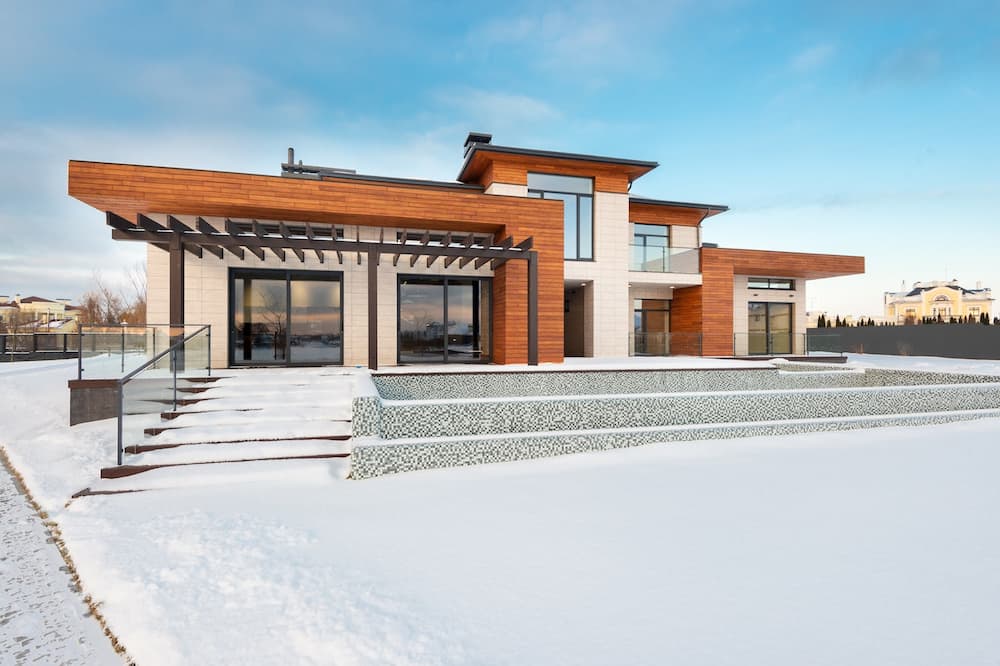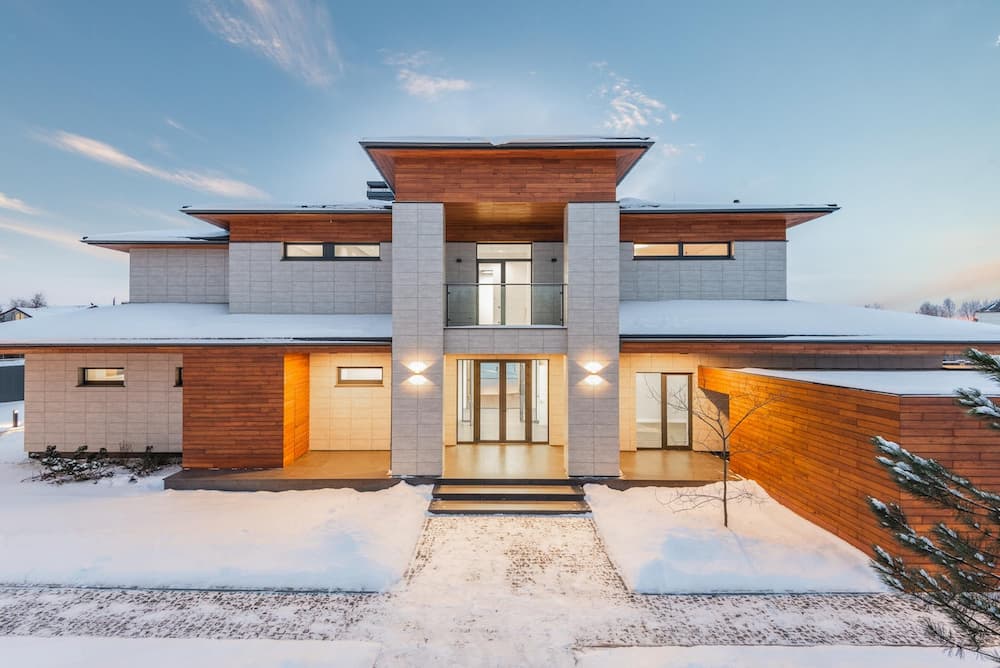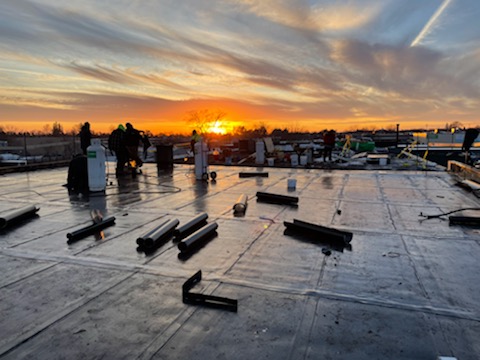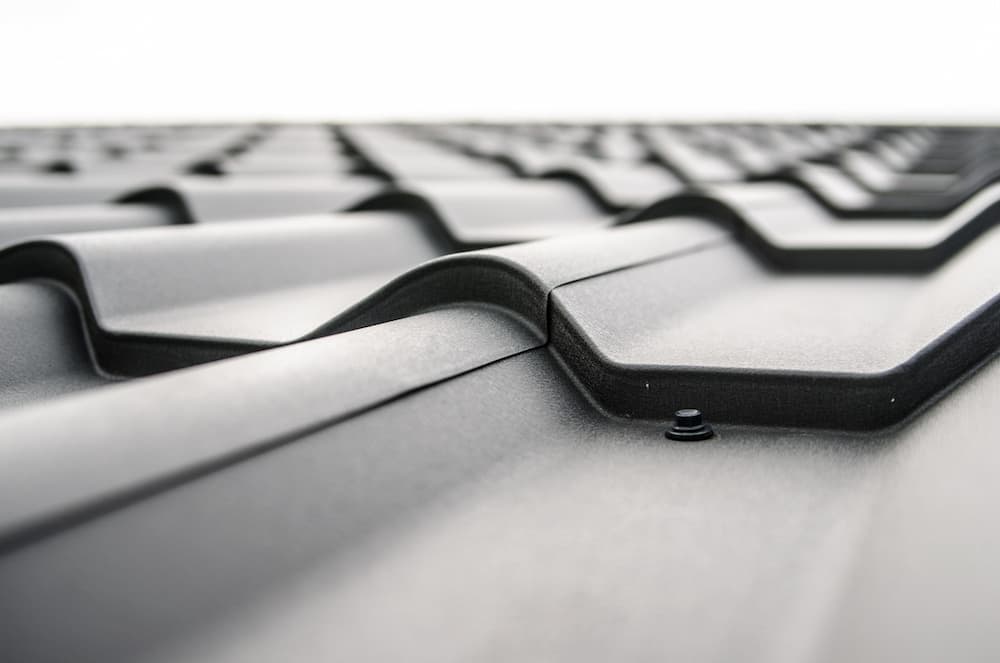Residential Flat Roof Construction Details: The Ultimate Guide
Historically, flat roofing systems were created for commercial and industrial structures, with residential flat roof construction being a more recent development. From the outset, a building’s roof has been viewed as an essential component of its details, design and function. Flat roofing offers several advantages over large surfaces due to its ease of installation, economical materials, and ability to fit into the overall aesthetic of a building.
But what about residential flat roof construction systems? Do they provide homeowners with the same benefits? Are they designed to the same standard as industrial and commercial roofs, and are they the right choice for residential buildings?
This guide hopes to answer these questions and more by examining residential flat roof construction, the various materials used in residential flat roofing, and the common applications of residential flat roofing. We will also look at some design and installation considerations for residential flat roofs, as well as tips on maintaining them and making them last for years.
Why is it Uncommon to Build a Flat Roof On a Home in Durham Region?
In Durham Region, residential flat roofs may require special consideration and maintenance due to the area’s frequent rain and snowfall. The low slope of a residential flat roof may cause water to collect rather than shed during these periods, leading to potential damage and flooding if not managed properly. However, a properly installed flat roof can be effective in climates with heavy precipitation thanks to installation techniques and modern materials.
To increase water shedding in residential flat roof construction, a slope of between five and 15 degrees is usually recommended – allowing water to flow into nearby drain systems. This will help reduce the amount of pooling water and reduce the risk of damage in residential flat roof systems.
Reasons to Choose a Flat Roof For Your Home in Durham?
Constantly improving drainage techniques:
With advances in technology, drainage systems have become increasingly effective in all types of flat roof construction – including residential. Products such as EPDM rubber membrane and TPO membrane are designed to minimize pooling water, while systems like gravel or stone pavers and synthetic grass have been developed to improve the aesthetics of a flat roof.
Good aesthetics:
Residential flat roofs are often chosen for their sleek and modern look. Without the need to worry about high slopes, a designer can take advantage of various materials and colours to make a unique statement. They can be an attractive aesthetic choice, adding to the overall look of your home and complementing the landscape or cityscape around it. This can be especially beneficial for those who live on a hill or have views from their home.
Practical uses for additional space:
The low-slope design of a flat roof enables homeowners to easily create additional living or entertaining space in their homes. Whether it’s a rooftop patio, garden, or green roof – the unique applications that can be achieved with flat roofs give homeowners more flexibility in what they can do with their homes. Additionally, solar panels and skylights are much easier to install and hide on a flat roof, making them an attractive choice for energy-conscious homeowners.
Related: Skylight installation in Durham Region
Can last and perform as well as pitched roofs:
Modern residential flat roofs are designed to be durable and long-lasting – with some materials boasting lifespans of up to 20 years or more. With contemporary technology and materials, flat roofs often outperform pitched roofs in terms of waterproofing and energy efficiency. In areas with frequent heavy rain or snow, an appropriate drainage system and insulation can be installed to further improve performance and reduce the risk of water damage.

Disadvantages of Installing a Residential Flat Roof
They are difficult to replace:
Due to improved technology and the use of modern waterproofing materials, flat roofs are no longer as difficult to replace as they once were, however, the process is still labour-intensive. Many companies specialize in residential flat roofing solutions, such as more durable underlayment and using a few layers of protection for improved performance and ease of installation. This could make replacing a flat roof quicker and more cost-effective than other roofing systems.
Higher risk of pooling water and leakage:
When poorly installed, flat roofs are more likely to experience water pooling and leakage than pitched roof systems. Poor drainage can cause water to stagnate in low spots, leading to the potential for damage from rot or mildew.
To reduce this risk, pay close attention to proper installation techniques and ensure that your roof is graded correctly so that water can flow easily into drainage systems. Ensure the slope is between 5 and 15 degrees, depending on the type of roof you are installing.
Related: How hot do black flat roofs get in Oshawa?
Components Of A Flat Roof
Flat roofs are made up of several components that work together to provide a waterproof barrier and protect your home from the elements. The most basic components of a flat roof include three major elements:
- Weatherproofing
- Reinforcement
- Surfacing
All these elements function together to form a waterproof system that can withstand extreme weather conditions. Weatherproofing materials such as membranes and modified bitumen are used to create a barrier that prevents moisture from entering the home.
Reinforcement materials such as asphalt concrete and fibreglass are also used to improve the strength of the roof and help it to last longer.
Finally, surfacing materials such as gravel or elastomeric coatings are applied to provide protection from ultraviolet radiation and improve the overall appearance of a flat roof.
Other Parts Of A Flat Roof
In addition to the main components mentioned above, residential flat roofs can also include several other important elements. These may include raised edges and metal flashing for improved drainage and water-tightness; insulation for added energy efficiency; ventilation systems to reduce humidity buildup; and sealants and coatings to protect the roof from damage caused by weathering or ultraviolet radiation.
All these components work together to form a fully waterproof residential flat roof construction that is both attractive and energy-efficient.

Warm vs Cold Roofs
A warm roof is one in which the insulation is placed above the waterproofing membrane, which helps keep the interior of your home warmer and more comfortable in the winter months. In contrast, a cold roof has insulation placed below the membrane, which helps keep your home cooler in the summer months. The type of roof you choose is largely dependent on local climate and personal preference.
In areas with cold winters, experts generally recommend against installing a cold roof because it promotes condensation and increases the risk of water damage. It also requires a ventilation system which can increase the complexity of residential flat roof construction, especially in small and medium-sized homes.
Types Of Residential Flat Roofing Materials
The type of material used for a residential flat roof can greatly affect the overall cost, performance, and durability of the structure. Let’s look at some of the most popular types of flat roofing materials, along with their pros and cons.
1. Built-Up Roofing (BUR)
This is one of the oldest and most trusted types of flat roofing materials, consisting of multiple layers of tar paper or asphalt sheets. It is common in both low-slope commercial and residential applications and is generally applied with hot asphalt or coal tar.
Materials:
BUR consists of alternating layers of tar paper and bitumen, usually asphalt, which is applied in a hot process. The layers provide strength and protection from the weather while allowing for watertight seams. The upper layer may be covered with a granular material, such as gravel or mineral chips, to provide further protection.
Method of Application:
Built-up roofing is typically applied in a hot process, using either asphalt or coal tar. The layers of the material are applied one at a time, with each layer overlapping the previous. The seams are then sealed with hot tar or asphalt to create a waterproof barrier.
Pros:
- BUR is very durable and can last up to 20-30 years, depending on local climate conditions
- It is relatively inexpensive
- The top layer of gravel provides increased protection from ultraviolet radiation, wind, and hail
- More layers provide immediate waterproof protection in case of a breach from any other
Cons:
- Hot asphalt can be labour-intensive and difficult to apply
- Difficult to repair and replace due to multiple layers
- It can be heavy and hard to handle
- The tar paper may crack or bubble due to temperature variations
2. Single-Ply Membranes
Single Ply membranes are a type of synthetic rubber or thermoplastic that is applied in one layer and designed to protect against water penetration. They are highly resistant to ultraviolet radiation and temperature variations, making them ideal for low-slope residential applications.
Materials:
Single-ply membranes typically consist of either EPDM (ethylene propylene diene monomer) or TPO (thermoplastic polyolefin). Both materials are lightweight and easy to install while also providing excellent protection against wind, rain, and hail.
Method of Application:
Single-ply membranes can be applied in three different ways: fully adhered, mechanically fastened, or ballasted. The type of installation is largely determined by the local climate and the slope of the roof surface. With a fully adhered system, the membrane is attached with an adhesive that chemically bonds it to the substrate. For a mechanically fastened system, the membrane is attached to the roof decking with special clips or plates that hold it securely in place, while a ballasted system relies on gravel for additional protection.

Pros:
- Take less time to install
- Highly resistant to temperature variations, ultraviolet radiation, and wind
- Provides excellent waterproof protection
- Flexible and can conform to the shape of the roof decking
Cons:
- Expensive material cost when compared to BUR
- Requires precise installation to ensure a watertight seal
- Come in large rolls which require heavy equipment to lift to the top
- Shrinkage may occur over time, creating gaps in the membrane
3. Thermoset (Synthetic Rubber)
Thermoset is a type of synthetic rubber that is applied in one layer and designed to protect against water penetration. It is highly resistant to ultraviolet radiation, temperature variations, and wind, making it ideal for low-slope residential applications.
Materials:
Thermoset consists of a rubber membrane (EPDM) and polyester reinforcement sheets (substrate) that are joined together with an adhesive. This combination creates an incredibly strong bond and makes the material durable enough to withstand extreme weather conditions.
Method of Application:
Thermoset is applied in a single layer and requires a trained professional to install it correctly. The membrane is rolled on with a roller, and then any cuts or seams are sealed using the included adhesive. It is also secured using ballasted materials such as gravel, which provides additional protection against wind and hail.
Pros:
- The flexible membrane allows for easier installation at penetrations and flashing
- Highly resistant to UV radiation
- Flexible synthetic rubber in cold weather climates
Cons:
- It is not suitable in dry, hot climates because it shrinks
- Requires specialized training to install correctly
- Requires heavy equipment to lift the large rolls of the membrane.
4. Thermoplastic (TPO)
Thermoplastic (TPO) is a single-ply membrane made of polypropylene and ethylene-propylene rubber that is applied in one layer and designed to protect against water penetration. It is highly resistant to ultraviolet radiation, temperature variations, and wind, making it ideal for low-slope residential applications.
Materials:
PVC (Polyvinyl chloride) or TPO membranes are made up of polypropylene and ethylene-propylene rubber, which is then heated and formed into a single-layer membrane.
Method of Application:
It is available in peel-and-stick, making it easy to apply. Sometimes a heat gun, roller, or brush with an adhesive is used to adhere to the membrane. It is then sealed along cuts and seams using an adhesive.
Pros:
- Lightweight and easy to install
- Due to the absence of chlorine, it is regarded as being environmentally friendly
- Both sun-reflecting and flameproof
- It is long-lasting and resistant to weathering
Cons:
- It is prone to punctures and tears due to its flexible nature.
- Installation requires specialized training and equipment.
- New product in the market
5. Modified Bitumen (or Polymer Modified Bituminous Materials)
Modified bitumen is a flexible, rubber-like material made from asphalt and other synthetic polymers that are designed to waterproof a roof. It is composed of several layers that are applied in a variety of methods.
Materials:
They are made up of asphalt and other synthetic polymers such as SBS (styrene-butadiene-styrene) or APP (atactic polypropylene).
Method of Application:
Modified bitumen membranes can be applied in several ways, including torch-down, self-adhered, and cold adhesive. Torch-down applications require the use of a flame to create a bond between the membrane and the roof deck, while self-adhered applications use a factory-applied adhesive.
Pros:
- Heat-welded seams make it highly waterproof
- Durable, long-lasting, and resistant to weathering
- Easy to repair or patch
- Highly puncture and tear-resistant
Cons:
- Highly vulnerable to foot traffic and mechanical damage
- Susceptible to ponding water if not installed correctly
- Labour intensive because more layers are involved and require specialized training
6. Liquid Applied Roofing
Technology has revolutionized the roofing industry, and liquid-applied roofing systems have become increasingly popular in North America. Liquid-applied roofs are seamless, lightweight, and easy to install as compared to traditional materials like modified bitumen or thermoset membranes.
Materials:
These systems are typically composed of bitumen and reinforced with glass fibres or other materials to provide extra strength and durability. They also contain elastomers which give them flexibility, allowing them to stretch and contract with the building structure.
Method of Application:
Liquid-applied roofing is usually applied with a roller and/or squeegee. It can also be cold-poured for larger applications. After application, it is left to cure, then a protective topcoat may be added for additional protection.
Pros:
- No heat welding is required, making installation faster and more cost-effective
- It can be applied directly over existing roof membranes
- Waterproofs immediately upon application
- Provides a seamless membrane
Cons:
- Installation requires specialized training and equipment
- Susceptible to ponding water if not installed correctly
7. Spray On Roofing
Spray-on roofing is a quick, easy, and cost-effective way to large waterproof areas in a short span of time. It is usually composed of an elastomeric material that can be applied directly to existing roof substrates, making it ideal for low-slope residential applications.
Materials:
It is typically made up of elastomeric materials such as silicone, aluminum, and acrylic. These materials are sun reflective and resistant to water and UV rays.
Method of Application:
The material is generally applied through a spray gun which atomizes it into a fine mist. It is sprayed over insulation or existing roof membranes and is allowed to cure.
Pros:
- Easy and quick application
- Creates a continuous waterproof membrane
- Excellent adhesion to existing substrates
Cons:
- It may require multiple coats for complete coverage
- It is expensive
8. Metal Roofing
From residential homes to commercial buildings, metal roofing is one of the most popular and durable materials available. It is fire-resistant, lightweight, and provides excellent protection against water damage.
Materials:
Metal roofs are made up of a variety of materials, such as steel, aluminum, copper, zinc, and other alloys. The material used will depend on the desired aesthetic, cost, and performance.
Method of Application:
Metal roofs are usually installed over a wood or metal substrate and fastened with screws or clips. They can be applied directly to existing roofs as well or used in conjunction with other materials such as shingles or foam insulation.
Pros:
- Extremely durable and long-lasting
- Low maintenance due to fire resistance, corrosion resistance, and wind resistance
- It can be used in conjunction with other materials for added protection
Cons:
- Expensive compared to other roofing options
- Heavy, which can add stress to a building’s structure
- Noise from rain or hail can be loud for occupants of the building.
How To Get The Most From Your Flat Roof
The key to getting the most from your flat roof is proper maintenance. Regular inspections and proactive repairs can make a significant difference in the lifespan of your roof system. Sealing seams, checking for ponding water, and repairing damage are all important steps to take. It is advised to perform a basic inspection twice a year and after any significant weather events. Here is a flat roof inspection checklist for you to follow:
- Make any necessary repairs or replacements as needed, and re-seal the roof to ensure a watertight barrier
- Check for any signs of damage or wear, including cracks, tears, and loose shingles. Replace any damaged parts as soon as possible to prevent leaks and further damage.
- Inspect the sealant, lap seams, flashings, and all other protrusions that penetrate the roof for signs of cracking, shrinking, hardening, or erosion.
- Look for evidence of water penetration, such as wet patches and water stains.
- Inspect the drainage system for blockages, clogs, or damage to outlets and downspouts that may prevent rainwater from flowing away from the roof.
- Check the insulation and ensure there is no trapped moisture that can lead to mould or other problems.
- Look for signs of ponding water, which is a common issue for flat roofs and can put added stress on the roof system that could lead to further damage.
- Check the roof substrate for any signs of rot or decay and make repairs if needed.
By following these steps and performing regular maintenance, you can ensure your flat roof is in good condition and able to last for many years.
Flat roof detail wrap-up
Overall, residential flat roof construction is becoming increasingly popular due to its aesthetic appeal, practical uses, and durability. The invention of new materials and technologies has made flat roofs more reliable than ever before, but regular maintenance and inspection are still key to ensuring optimal performance. Different roofing types serve different purposes, so make sure to choose the right one for your home, as each type of roof offers unique advantages and disadvantages.
Whether you’re planning to install a new flat roof or are just looking for ways to extend the life of your existing roof, we have enlightened you on the benefits and maintenance of a flat roof. We hope this guide has provided you with the information needed to make an informed decision about your roofing choice, and we wish you the best of luck in your roofing projects.



